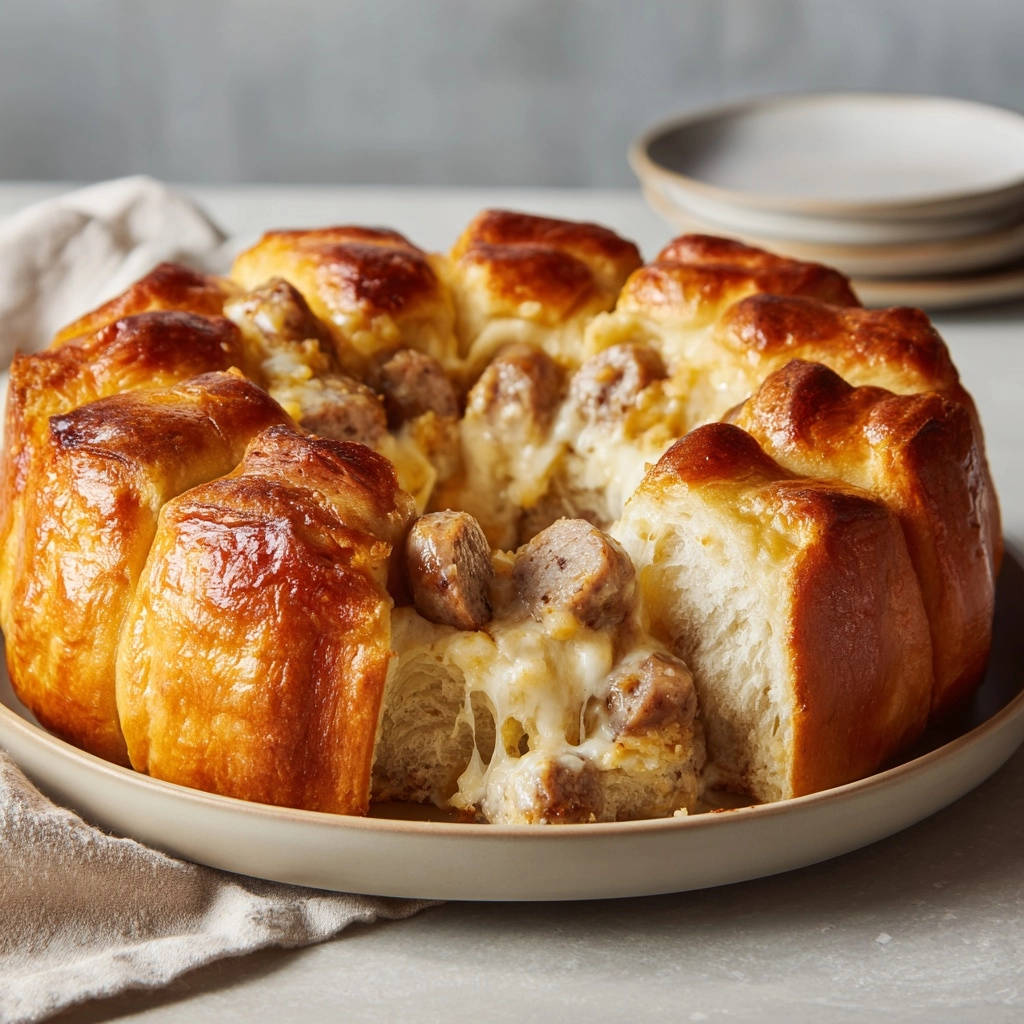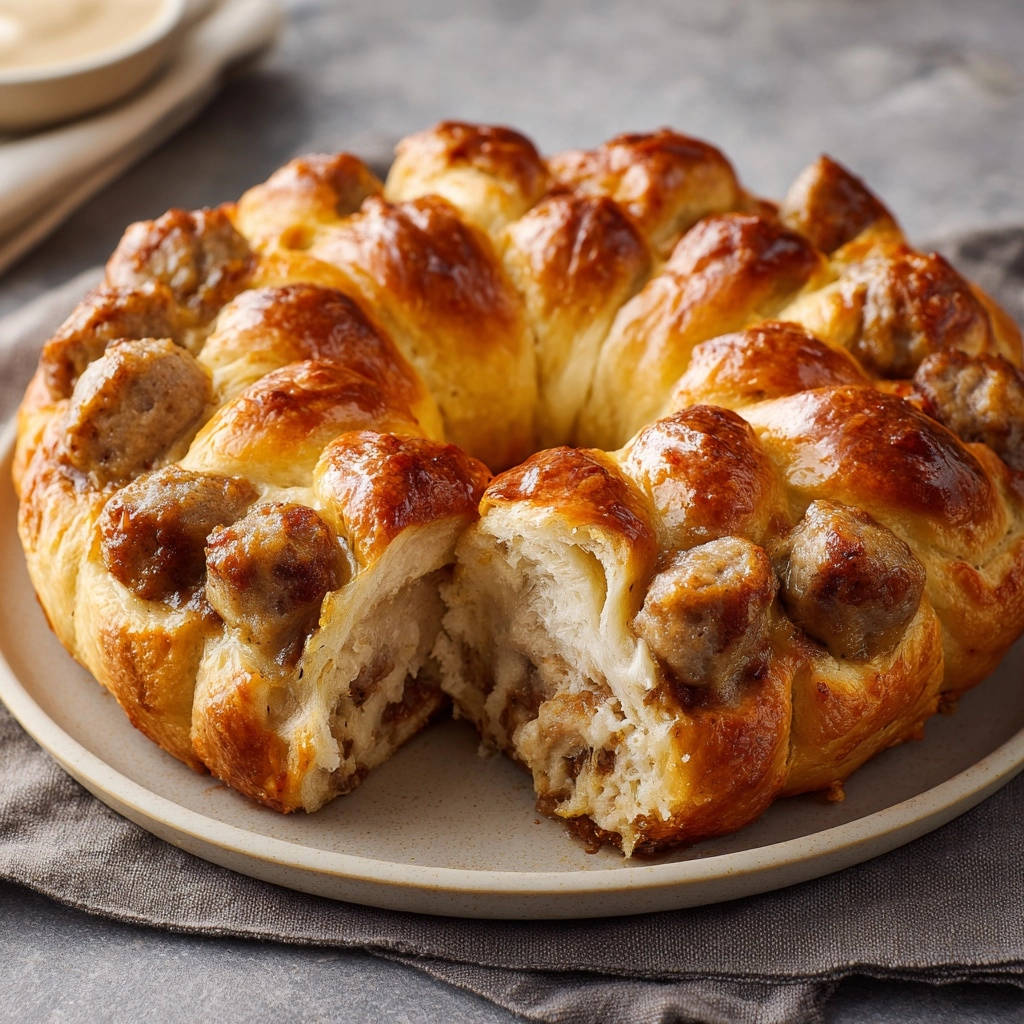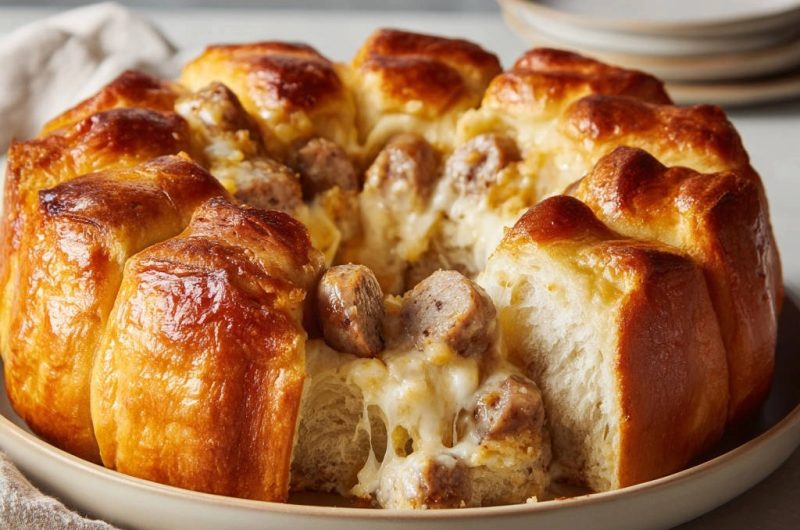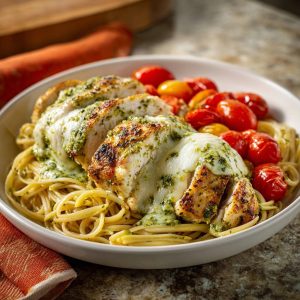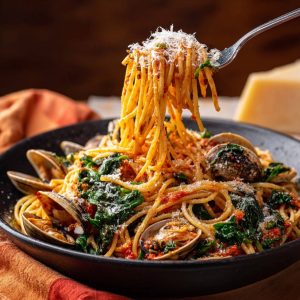Have you ever found yourself craving a savory, comforting bread, only for it to turn out disappointingly dense? I certainly used to struggle with achieving that incredible, airy texture, but I’ve finally perfected the method for the most heavenly Cheesy Sausage Pull-Apart Bread.
This recipe transforms simple ingredients into a golden, pull-apart masterpiece, bursting with savory sausage and gooey cheese, ensuring a beautifully light and fluffy result every single time. It’s truly a game-changer for breakfast, brunch, or a satisfying snack.
Why This Cheesy Sausage Pull-Apart Bread Stands Out
This isn’t just another bread recipe; it’s a testament to simple techniques delivering extraordinary results. Here’s what makes this particular Cheesy Sausage Pull-Apart Bread truly exceptional and why it deserves a spot in your recipe rotation.
The Secret to Unrivaled Fluffiness (No More Dense Bread!)
The core of this recipe’s success lies in precise yeast activation and a dual-rise process. We ensure the yeast is vigorously active from the start, guaranteeing a robust rise.
Combined with proper kneading, this dual proofing develops the gluten perfectly, creating a structure that holds its incredible lightness. Say goodbye to heavy, brick-like bread!
Effortless Elegance for Any Occasion
While looking impressive, this pull-apart bread is surprisingly straightforward to make. Its stunning presentation makes it ideal for a special brunch centerpiece, a potluck showstopper, or a delightful addition to any family meal.
It’s designed to be easily portioned, making it a no-fuss option for serving crowds or simply enjoying with loved ones.
A Flavor Combination Everyone Craves
The classic pairing of savory breakfast sausage and a rich blend of cheddar and mozzarella cheeses is universally appealing. Each bite offers a harmonious balance of salty, savory, and cheesy notes.
It’s the kind of comforting flavor profile that brings smiles to faces, satisfying appetites big and small.
The Building Blocks: What You’ll Need
Crafting this incredible savory bread requires a few key ingredients. Quality matters, as each component plays a vital role in the final texture and flavor.
Dough Essentials: Flour, Yeast, and Dairy
All-purpose flour provides the essential structure for our dough. Its protein content develops gluten, which is crucial for elasticity and chew.
Active dry yeast is the leavening agent responsible for the bread’s airy texture. Ensuring it’s fresh and properly activated is the single most important step for a successful rise.
Warm milk activates the yeast and contributes to a tender crumb. Unsalted butter adds richness and moisture, keeping the bread soft and flavorful.
Savory Core: Sausage and Cheese
Cooked breakfast sausage, crumbled finely, provides a hearty and flavorful base. Choose your preferred type, ensuring it’s fully cooked before mixing into the dough.
A blend of shredded cheddar and mozzarella cheese offers the best of both worlds: sharp cheddar for flavor depth and gooey mozzarella for that irresistible stretch.
Pantry Staples: Salt, Sugar, and Egg
Granulated sugar feeds the yeast, helping it activate quickly and contributing to the bread’s golden crust. Just a touch makes a big difference.
Salt is essential for flavor balance and also helps regulate yeast activity. It ensures the bread isn’t bland and enhances all the other flavors.
A large egg, lightly beaten, acts as a wash to help the sausage and cheese adhere to the dough, and promotes a beautiful golden-brown crust during baking.
Essential Tools for Your Pull-Apart Bread Journey
Having the right equipment ensures a smooth and enjoyable baking process. These tools are fundamental to achieving the perfect Cheesy Sausage Pull-Apart Bread.
Mixing Bowls and Whisk
You’ll need a large mixing bowl for combining your dough ingredients and allowing the dough to rise. A sturdy whisk or spoon is perfect for initial mixing.
Bundt Pan: The Key to Its Iconic Shape
A 9-inch Bundt pan is crucial for achieving the distinctive pull-apart shape. Its fluted design allows the individual pieces to separate easily after baking, creating a truly communal eating experience.
Measuring Tools & Kitchen Scale (Optional but Recommended)
Accurate measurements are vital in baking for consistent results. Have your measuring cups and spoons ready.
While optional, a kitchen scale offers unparalleled precision for flour and other dry ingredients. This can elevate your baking from good to consistently great.
Your Path to Perfect Cheesy Sausage Pull-Apart Bread: Step-by-Step
Follow these detailed steps carefully, and you’ll be rewarded with a truly magnificent pull-apart bread. Each stage is designed for success.
Step 1: Activating the Yeast (The Golden Rule for Rise!)
In a large bowl, combine the warm milk, yeast, and sugar. The milk should be comfortably warm, between 105-115 degrees F (40-46 degrees C), like a warm bath.
Let this mixture sit undisturbed for 5-10 minutes. It’s ready when a visible layer of foam or bubbles forms on the surface, confirming your yeast is active and ready to make your bread beautifully fluffy. If no foam appears, your yeast may be old or the water too hot/cold, and you should start with a fresh packet.
Step 2: Forming the Dough & First Rise
Add the flour and salt to your activated yeast mixture. Stir with a spoon until a shaggy, somewhat sticky dough forms; don’t worry about it being perfectly smooth yet.
Turn the dough out onto a lightly floured surface. Knead the dough for 8-10 minutes. This process is crucial for developing gluten, which gives the bread its elasticity and wonderfully light, chewy texture. The dough should transform from shaggy to smooth and elastic, feeling springy to the touch.
Grease a clean bowl with a little melted butter, then place the dough in, turning once to coat. Cover tightly with plastic wrap and let it rise in a warm, draft-free place for 60-90 minutes, or until it has visibly doubled in size. This first rise allows the yeast to work its magic, developing both flavor and texture.
Step 3: Preparing Your Savory Filling
While the dough undergoes its first rise, prepare your fillings. Ensure your breakfast sausage is fully cooked and crumbled into small, bite-sized pieces. If using bulk sausage, brown it first and drain any excess grease.
Have your shredded cheddar and mozzarella cheese blend ready. The combination provides both sharpness and a perfect gooey melt.
Step 4: Shaping and Layering in the Pan
Once your dough has doubled in size, gently punch it down to release the air. This helps to redistribute the yeast and create a more uniform texture in the final bread.
Roll the dough out onto a lightly floured surface into a rectangle approximately 12×18 inches. Brush the melted egg evenly over the entire surface of the dough – this acts as a glue for the fillings and contributes to a beautiful crust.
Sprinkle the cooked sausage and shredded cheese evenly over the egg-washed dough, ensuring coverage right to the edges. Now, cut the dough into approximately 2-inch squares.
Generously grease a 9-inch Bundt pan with the remaining 2 tablespoons of melted butter, paying extra attention to all the crevices to prevent sticking. Gently stack the dough squares, sausage and cheese side up, into the prepared Bundt pan. Don’t pack them too tightly; they need room to expand.
Step 5: The Crucial Second Rise (Proofing for Puffiness)
Loosely cover the Bundt pan with plastic wrap or a clean kitchen towel. Let the dough rise again in a warm place for 30-45 minutes, or until it has visibly puffed up and appears airy.
This second rise, also known as proofing, is vital for giving the bread its final lift and incredible light, fluffy texture. Don’t skip or rush this step!
Step 6: Baking and Golden Finish
Preheat your oven to 375 degrees F (190 degrees C) during the last 10-15 minutes of the second rise. This ensures the oven is at the correct temperature for immediate baking.
Bake for 30-35 minutes, or until the top is beautifully golden brown and the internal temperature reaches 200-205 degrees F (93-96 degrees C) with a digital thermometer. If you notice it browning too quickly, loosely tent the top with aluminum foil to prevent over-browning.
Once baked, let the bread cool in the Bundt pan for 10 minutes. This allows it to firm up slightly before you invert it onto a serving platter. Serve warm and encourage everyone to pull apart the cheesy, sausage-filled goodness!
Mastering Your Cheesy Sausage Pull-Apart Bread: Expert Tips
Even seasoned bakers can benefit from these insider tips to ensure your pull-apart bread is nothing short of perfection.
Don’t Rush the Rises: Patience Pays Off
Under-proofing is a common culprit for dense bread. Always allow your dough to rise fully until doubled in size or visibly puffed. This patience allows for proper gluten development and aeration, leading to that coveted light texture and richer flavor.
Perfect Kneading for the Right Texture
The 8-10 minutes of kneading might seem long, but it’s essential. This step develops the gluten, creating a strong, elastic framework that traps the gas produced by the yeast, resulting in a lofty, airy bread. Look for a smooth, pliable dough that springs back when gently poked.
Bundt Pan Prep: Avoid Sticking Nightmares
Be incredibly generous when greasing your Bundt pan, especially in all the intricate nooks and crannies. Use melted butter or a good quality non-stick spray. A well-greased pan ensures your beautiful bread releases effortlessly after baking, preserving its iconic shape.
Temperature Checks for Doneness
While golden brown is a good visual cue, for perfect doneness, use a digital thermometer. Inserting it into the center of the bread should register between 200-205 degrees F (93-96 degrees C). This guarantees the bread is cooked through without being dry or gummy.
Warmth is Your Yeast’s Best Friend
Yeast thrives in warmth. Find a cozy, draft-free spot for your dough to rise. This could be a slightly warmed oven (turned off!), near a sunny window, or on top of a warm appliance. Consistent warmth promotes steady and effective rising.
Troubleshooting Your Pull-Apart Bread: Common Fixes
Even with the best intentions, baking can sometimes present challenges. Here are solutions to common issues you might encounter with your Cheesy Sausage Pull-Apart Bread.
Why Is My Bread Dense or Heavy?
This is usually due to insufficient yeast activity, under-kneading, or rushing the rising process. Ensure your yeast is fresh and foamy in step 1. Dedicate the full 8-10 minutes to kneading to develop gluten. Always allow the dough to rise until it’s truly doubled in size for both rises.
My Bread Didn’t Rise!
If your bread didn’t rise, the most common culprits are dead yeast, milk that was too hot (killing the yeast) or too cold (inhibiting activation), or a rising environment that was too cold. Always check yeast activation in step 1. Ensure your milk is comfortably warm, and find a genuinely warm, draft-free spot for proofing.
The Top is Browning Too Quickly
If the top of your pull-apart bread is browning faster than the rest of the bread is cooking through, your oven temperature might be slightly too high, or your oven has hot spots. Loosely tenting the bread with aluminum foil about halfway through baking will protect the top while the inside finishes cooking. You can also try rotating the pan halfway through baking.
Serving Suggestions & Storage Solutions
This Cheesy Sausage Pull-Apart Bread is a treat any time of day. Here’s how to best enjoy it and keep it fresh.
Best Ways to Enjoy Your Freshly Baked Bread
This bread is best served warm, allowing the cheese to remain gooey and the sausage flavors to shine. It makes an incredible savory breakfast or brunch centerpiece, especially alongside scrambled eggs or a simple fruit salad.
It also serves as a fantastic, hearty side dish for dinner, perfect with soups or stews. Its pull-apart nature makes it ideal for sharing, encouraging a fun, communal dining experience.
How to Store Leftovers for Optimal Freshness
Store any leftover pull-apart bread in an airtight container at room temperature for up to 2 days. For longer storage, refrigerate for up to 5 days.
To reheat, simply warm individual portions in the microwave for 15-30 seconds, or wrap the whole loaf loosely in foil and reheat in a 300°F (150°C) oven until warmed through and the cheese is soft again.
Make-Ahead Options for Easy Entertaining
You can prepare elements of this recipe in advance. Cook and crumble the sausage a day ahead. The dough itself can be made, allowed to complete its first rise, then punched down and refrigerated overnight. Bring it back to room temperature for about 30 minutes before proceeding with shaping and the second rise.
Your Cheesy Sausage Pull-Apart Bread Questions Answered
I get a lot of questions about making various savory breads. Here are some common inquiries regarding this delicious pull-apart bread.
Can I use different types of sausage or cheese?
Absolutely! Feel free to experiment with your favorite cooked sausage, such as mild Italian sausage (browned and crumbled) or even a spiced turkey sausage. For cheese, a sharp provolone or a Monterey Jack could be lovely alternatives or additions to the cheddar and mozzarella blend. For another take on savory pull-apart goodness, you might enjoy trying a Cheesy Bacon Jalapeño Pull-Apart Bread for a spicy kick.
Is there a gluten-free alternative for this recipe?
While possible, using a gluten-free all-purpose flour blend will alter the texture significantly. Gluten-free doughs typically require different handling and may not achieve the same airy, stretchy quality. Look for a blend specifically designed for yeast breads, and be prepared for a denser crumb.
How long does the bread stay fresh?
When stored properly in an airtight container, this Cheesy Sausage Pull-Apart Bread is best enjoyed within 2 days at room temperature for peak freshness and texture. It can be refrigerated for up to 5 days, though the texture might become slightly firmer.
Can I freeze Cheesy Sausage Pull-Apart Bread?
Yes, this bread freezes beautifully! Once completely cooled, wrap the entire loaf tightly in plastic wrap, then in aluminum foil. It can be frozen for up to 3 months. To reheat, thaw overnight in the refrigerator, then warm in a 300°F (150°C) oven until heated through. Alternatively, for more cheesy bread inspiration, explore a classic Cheesy Pull-Apart Bread recipe for even more delightful options.
Ready to Bake? Share Your Pull-Apart Bread Masterpiece!
Now that you have all the tips and tricks for baking the perfect Cheesy Sausage Pull-Apart Bread, it’s time to get into the kitchen. This recipe is designed to deliver delicious results that will impress everyone.
I can’t wait to see your culinary creations! Share your beautiful bakes with me on social media, or leave a comment and review below to let me know how it turned out. Happy baking, and enjoy every savory, cheesy, fluffy bite!
Cheesy Sausage Pull-Apart Bread
Course: BreadCuisine: American CuisineDifficulty: easy8
servings25
minutes35
minutes60
minutesAmerican Cuisine
Ingredients
1 cup warm milk (around 105-115 degrees F)
2 and 1/4 teaspoons active dry yeast (one packet)
1 tablespoon granulated sugar
3 cups all-purpose flour, plus more for dusting
1 teaspoon salt
1/4 cup unsalted butter, melted, plus 2 tablespoons for pan
1 large egg, lightly beaten
8 ounces cooked breakfast sausage, crumbled
2 cups shredded cheddar and mozzarella cheese blend
Directions
- In a large bowl, combine the warm milk, yeast, and sugar. Let it sit for 5-10 minutes until foamy. This is the crucial step for a fluffy bread, ensuring your yeast is active and ready to work!
- Add the flour and salt to the yeast mixture. Mix with a spoon until a shaggy dough forms.
- Turn the dough out onto a lightly floured surface. Knead the dough for 8-10 minutes until it becomes smooth and elastic. Proper kneading develops the gluten, which is key to a light and airy texture. Don’t skip this step!
- Grease a clean bowl with a little melted butter. Place the dough in the bowl, turning once to coat. Cover with plastic wrap and let it rise in a warm, draft-free place for 60-90 minutes, or until doubled in size. This first rise is essential for flavor and texture development.
- While the dough rises, prepare your sausage and cheese. Make sure the cooked sausage is crumbled into small, bite-sized pieces.
- Once the dough has doubled, gently punch it down to release the air. This helps create a uniform texture.
- Roll the dough out onto a lightly floured surface into a rectangle, about 12×18 inches. Brush the melted egg over the entire surface of the dough.
- Sprinkle the cooked sausage and shredded cheese evenly over the dough.
- Cut the dough into approximately 2-inch squares.
- Generously grease a 9-inch Bundt pan with the remaining 2 tablespoons of melted butter, ensuring all crevices are coated to prevent sticking.
- Gently stack the dough squares, sausage, and cheese side up, into the prepared Bundt pan. Don’t pack them too tightly.
- Cover the pan loosely with plastic wrap and let it rise again in a warm place for 30-45 minutes, or until visibly puffed. This second rise, or proofing, gives the bread its final lift and incredible fluffiness.
- Preheat your oven to 375 degrees F (190 degrees C).
- Bake for 30-35 minutes, or until the top is golden brown and the internal temperature reaches 200-205 degrees F. If it browns too quickly, you can loosely tent it with foil.
- Let the bread cool in the pan for 10 minutes before inverting it onto a serving platter. Serve warm and pull apart to enjoy!
Notes
- Activating your yeast and proper kneading are key for the ultimate fluffy texture. Don’t skip the second rise for best results!

